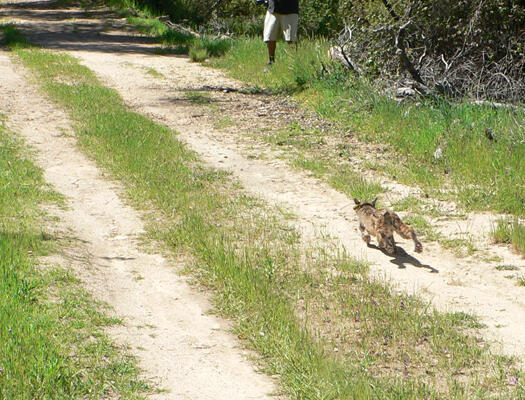Duke the college basketball team may have stumbled out of the gate this March, but Duke the bobcat was able to defeat malnourishment and mange and bounce back to the victory of health and freedom.
Bobcats (Lynx rufus) are a common carnivore denizen of suburban southern California, and USGS Western Ecological Research Center biologists collaborate with many local partners and agencies to study the health of bobcat populations. As one of the top predators in the local food web and a highly mobile one at that, bobcat populations can serve as indicators on the health and status of the local landscape.
Along the way, there's usually a rewarding story or two.
Back on March 12, 2012, a project led by Megan Jennings and Rebecca Lewison of San Diego State University found Duke in a research trap in eastern San Diego. Jenning's research collaborators are Erin Boydston and Lisa Lyren, who lead WERC research projects on urban carnivore ecology throughout southern California.
Duke was emaciated and had severe mange, weighing only 12 pounds. Typically, researchers sedate, examine and attach a tracking collar on bobcats before immediately releasing them to the wild. But Duke was too frail, and Jennings and colleagues decided to send him to the Fund For Animals Wildlife Center for rehabilitation.
Fast forward to April 2, 2012: Duke is free of mange. His fur is dense and healthy, and he's beefed up to a sturdy 17 pounds. Time to head home.
Local news crews were on hand as Jennings, Lyren and staff from Fund for Animals gave Duke one last check up and a tracking collar, before sending home in the hills of Ramona:
- Watch the video of Duke bounding back to freedom (KFMB CBS News8)
- Read about Duke's release (North County Times)
Lyren and Boydston will continue to work with Jennings and other local researchers to understand how bobcats and other carnivores are responding to ecological changes. Factors like housing developments, roadways, diseases, and climate change can affect bobcat behavior and survival, so bobcat tracking studies offer researchers a glimpse into how the natural landscape of southern California are being fragmented or influenced by natural and man-made factors.
Among their focus is evaluating the connectivity of landscapes in key areas of San Diego's open space network, and determining whether corridors exist for bobcats and other wildlife to move around naturally. If there is poor connectivity, it could be a sign that habitats are too fragmented and may restrict the genetic health of various wildlife species.
And Duke will help us answer these questions.
-- Ben Young Landis
All images courtesy of Megan Jennings/San Diego State University.
Get Our News
These items are in the RSS feed format (Really Simple Syndication) based on categories such as topics, locations, and more. You can install and RSS reader browser extension, software, or use a third-party service to receive immediate news updates depending on the feed that you have added. If you click the feed links below, they may look strange because they are simply XML code. An RSS reader can easily read this code and push out a notification to you when something new is posted to our site.




